Wind comfort, and the criterion used to evaluate this perception, is based upon numerical concepts to capture how people feel in differing wind conditions, at varying activity levels. To test and determine the level of pedestrian wind comfort in an urban area, the local wind speed must be related to the weather station data. By doing this, the probability of the local wind speed exceeding the given threshold wind speeds defined by wind comfort criteria can be ascertained. Yet, as geographic locations, terrain and landscape features, and cultural perceptions innately vary across the globe, there cannot be a ‘one-size-fits-all’ criteria for wind comfort.
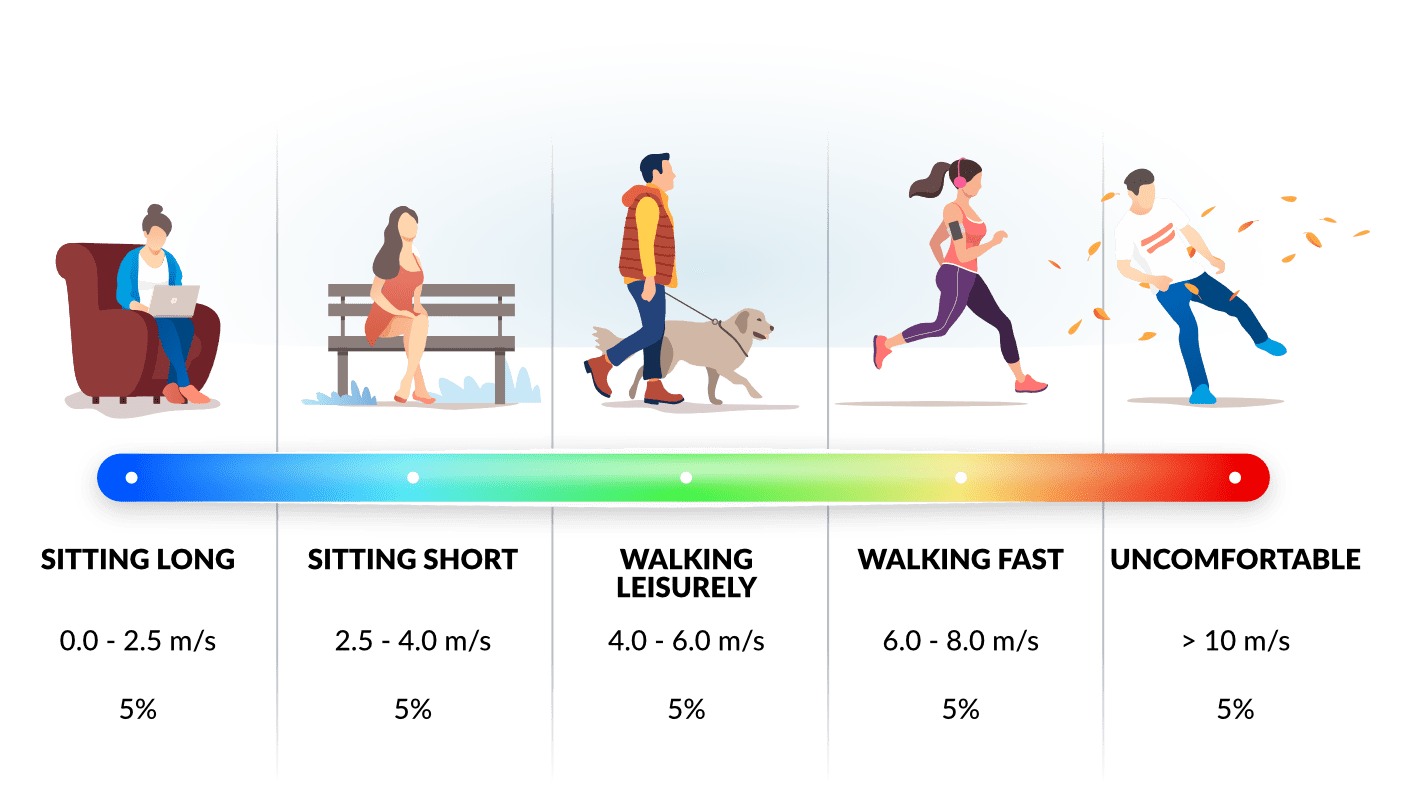
While there is no all-encompassing wind comfort criteria standard, there are many standards existing today to aid assessment of predicted wind environment for the built environment, by providing parameters of what should be achieved to stay within favorable conditions. To note the standards used widely by engineers around the globe, Lawson, Davenport, and NEN 8100 are among the internationally recognized.
In this article, we will focus on Lawson wind comfort criteria, and extrapolate on how even within this comfort standard there are further denominations to accommodate different variations of threshold wind speeds. Along with this, we will provide visual simulation examples from the SimScale platform to illustrate the different findings.
This paper addresses the topic of pedestrian wind comfort, from origin and
definition to wind comfort analysis, criteria, and example case studies; all meant to
form an in-depth understanding of the field.
What Are the Lawson Wind Comfort Criteria?
The Lawson criteria are defined by the probability of one particular location to see wind speed higher than a certain speed. These speeds are measured at a particular height which is usually between 1.5 m and 1.75 m depending on the local authority rules. In simpler terms, the Lawson criteria set threshold wind speeds, and then dictate the probability of wind speeds exceeding that threshold.
The different wind speed threshold values, as well as the probability values, make the level of comfort for pedestrians. They usually correspond to an activity that would be able to be achieved in an acceptable manner, such as sitting, standing, walking fast, etc. The probability is calculated using statistical weather data. This statistical data is obtained from a year-round data collection of wind speed and frequency in 4 to 36 directions.
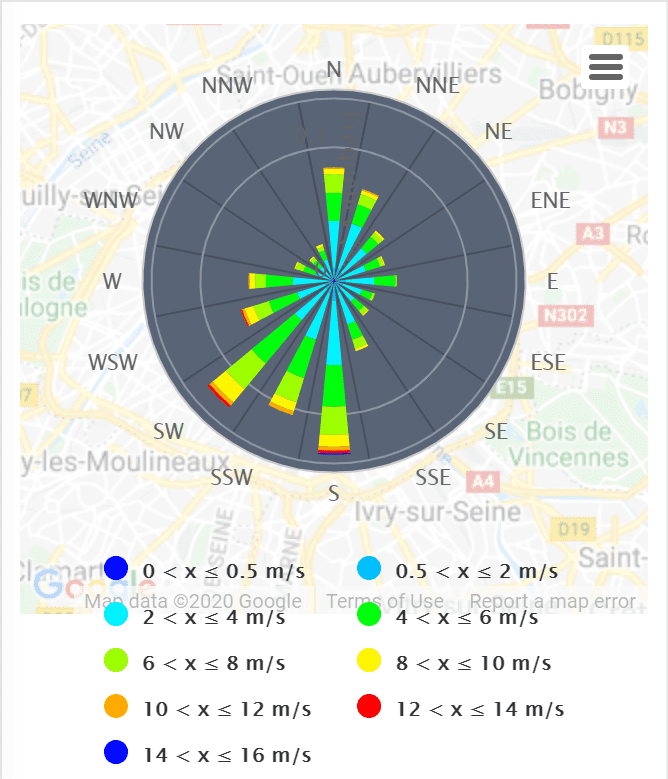
Starting with the highest threshold speed (the most uncomfortable or unsafe condition), the probability at each specific point is calculated, and if the probability is less than the one stated by the category, then the category velocity range is satisfied (and the wind velocity deemed safe for pedestrians!). The calculation continues with the following threshold speeds until the fulfillment isn’t met anymore, which means the probability is higher than the one set by the category. This means that this specific point has its wind comfort criterion set to the last fulfilled, where the probability was lower than the one set. This computation is made for each point, and for each direction. At each point, and for each direction, the threshold speed is scaled by an amplification factor computed from a combination of CFD results and meteorological data. This meteorological data takes into account the terrain type in each direction; they are associated with a factor value that represents how the wind is slowed down by obstacles like buildings or trees.
Within the Lawson standard, there are subtypes to accommodate different cultural perceptions, geographical locations, and local authorities. The wind speed thresholds used, as well as the probability values for each threshold, make up the type of Lawson criteria used. The different subtypes of the Lawson criteria (LDDC, 2001, 1970 etc.) will have different probability values and wind speed thresholds.
General Lawson Criteria
In its original form, Lawson wind comfort criteria are made up of five different categories that all use a probability of 2% as a fulfillment value.
The “Uncomfortable” (red/E) category indicates the most undesired areas, where the value of the speed is higher than 7.6 m/s, is likely to be more than 2% of the time. This category is usually quite rare, and as seen below we usually only see a small number of such zones on a wind comfort map. If such zones are used by pedestrians or cyclists, action should be taken in order to alleviate these unwanted conditions.
The category “Walking Fast”, shown in yellow, corresponds to points where the likelihood of seeing a wind speed higher than 7.6 m/s is likely to be less than 2% of the time. Basically this is true for all lower categories as well. So here the wind requirements of this category are met, but not those of categories A, B, and C. These points would indicate areas of concern depending on the intended use of the area (i.e., an outdoor dining restaurant would not work in these conditions). Typically, there is a threshold (linked again to the local authorities and wind standard) that is a “good quality” if the criteria of the designated usage are met, “acceptable” if it’s one category worse and “unacceptable” if it’s worse two or more categories.
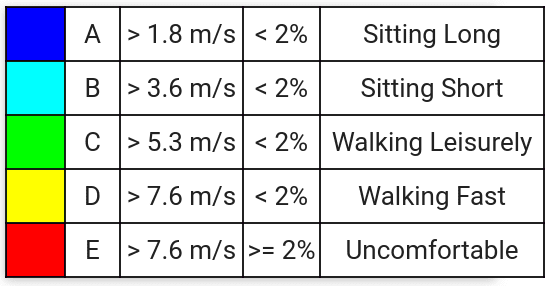
The following categories, shown in green, light blue, and blue, represent points where the speeds higher than 5.3 m/s, 3.6 m/s, 1.8 m/s respectively are less than 2% likely to be observed. These points indicate normal conditions that pedestrians would most likely find comfortable. Under the given activities.

Lawson LDDC Criteria
The Lawson LDDC wind comfort criteria is a subset made of 6 different categories; the safest 5 categories use a probability of 5% as a fulfillment value. The “Unsafe” category, shown in red, represents areas with the likelihood of experiencing a wind speed higher than 15 m/s is more than 0.022%. Should some passage zones be classified with this category, safety measures must be put in place to reduce risks of accidents.
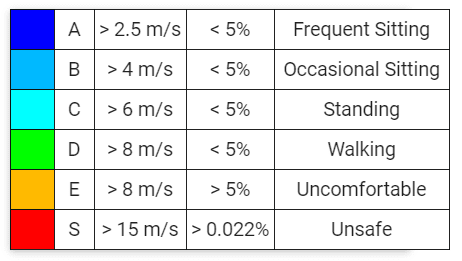
The following category, corresponding to “Uncomfortable” zones, shown in orange, corresponds to points where the likelihood of seeing a speed more than 8 m/s is higher than 5% of the time. Depending on the usage of such zones by pedestrians or cyclists, adequate measures should be taken.
The next categories; “Walking” ( D ), “Standing” ( C ), “Occasional sitting” ( B), and “Frequent sitting” ( A ) represent points where speeds of more than 8 m/s, 6 m/s, 4 m/s, 2.5 m/s respectively are less than 5% likely to be observed.
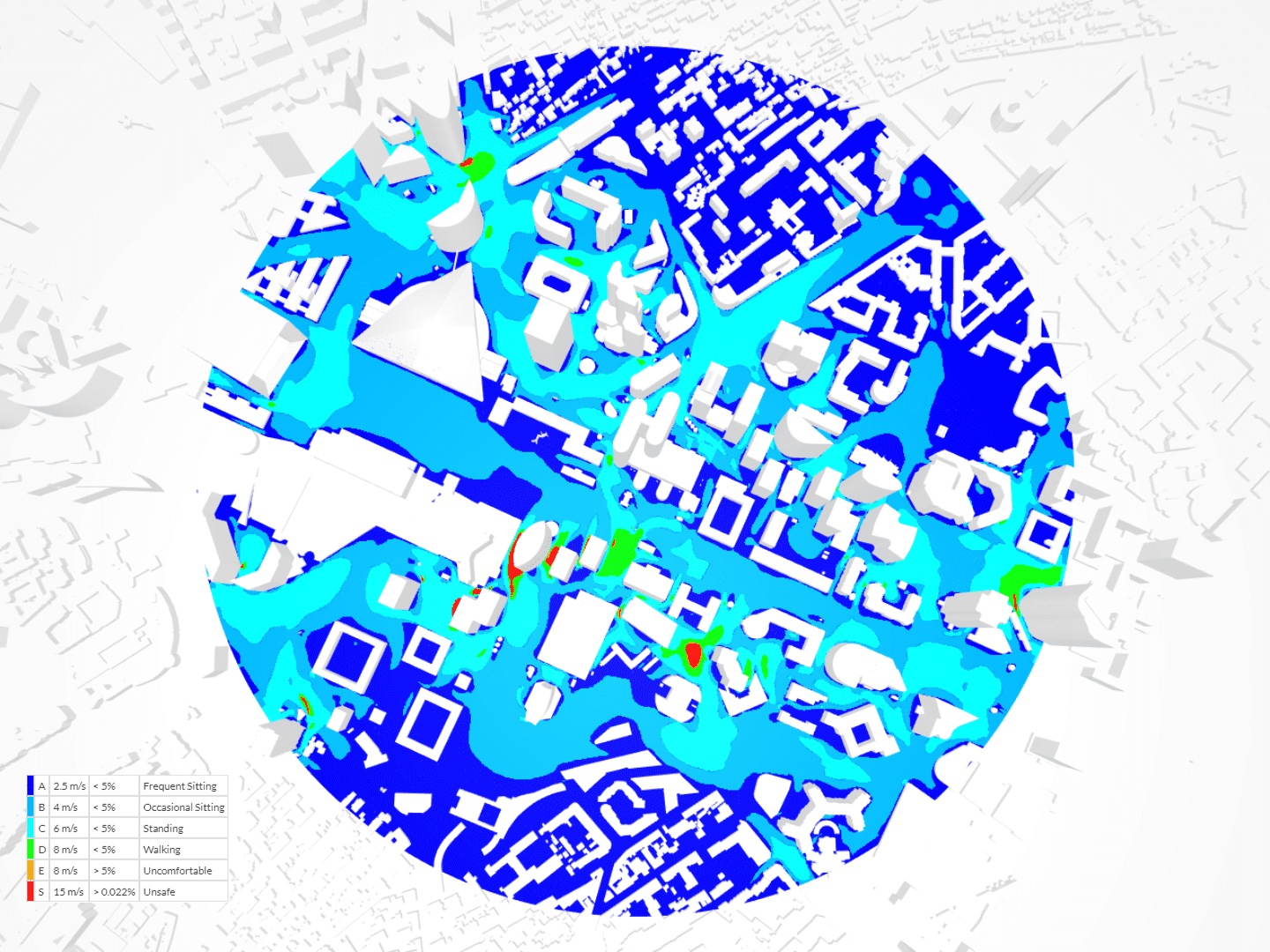
Lawson 2001 Criteria
The Lawson 2001 wind comfort criteria use categories ranging from A to E with the addition of two extra categories, both called “S”.
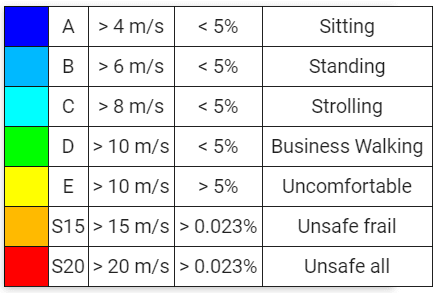
The most undesired “S” category, called “Unsafe all” and shown in red, is represented by areas likely to experience more than the 20 m/s threshold speed more than 0.023% of the time. Second to this category, called “Unsafe frail”, is showing areas with the potential to experience more than 15 m/s wind speed more than 0.023% of the time. This is the orange category.
The “uncomfortable” category, in yellow, shows the locations where the likelihood of seeing a wind speed higher than 10 m/s is higher than 5%.

The categories from A “Sitting” to E “Uncomfortable” represent zones where speeds higher than 10 m/s, 8 m/s, 6 m/s, 4 m/s, and 2 m/s respectfully are less than 5% likely to be observed.
Conclusion
Widely used in the AEC industry, the Lawson wind comfort criteria is recognized as an effective method when it comes to assessing pedestrian wind comfort for urban environments and cityscapes. It uses different threshold speeds and calculates probability given by the CFD results, the meteorological and terrain information, and the wind rose data. These make different levels or categories of comfort for pedestrians, they correspond to either a state (fail, unsafe), feeling (uncomfortable) or an activity (outdoor dining).
Based on the location, wind environment, and landscape of where engineers would like to build or expand on a design, these subsets of the Lawson criteria can help engineers make better and more specific design decisions. Here at SimScale, we offer different wind comfort analysis tools and standards to better fit your evaluation needs, and investigate pedestrian wind comfort in any location around the globe.
More Wind Comfort Resources from SimScale
- Wind Comfort Criteria: Lawson, Davenport, and NEN 8100
- How to Analyze Pedestrian Wind Comfort with SimScale
- Sustainable Wind Engineering: The Stockholm Royal Seaport Project



